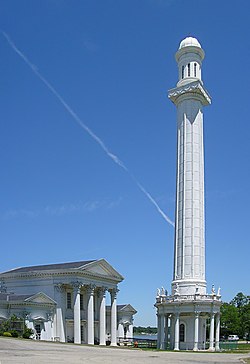Louisville Water Tower
|
Louisville Water Company Pumping Station
|
|
 |
|
| Location | Louisville, Kentucky |
|---|---|
| Coordinates | 38°16′50″N 85°42′4″W / 38.28056°N 85.70111°WCoordinates: 38°16′50″N 85°42′4″W / 38.28056°N 85.70111°W |
| Built | 1860 |
| Architect | Scowden,Theodore R. |
| Architectural style | Classical Revival |
| NRHP Reference # | 71000348 |
| Added to NRHP | November 11, 1971 |
The Louisville Water Tower, located east of downtown Louisville, Kentucky near the riverfront, is the oldest ornamental water tower in the world, having been built before the more famous Chicago Water Tower. Both the actual water tower and its pumping station are on the National Register of Historic Places. As with the Fairmount Water Works of Philadelphia (designed 1812, built 1819–22), the industrial nature of its pumping station was disguised in the form of a Greek temple complex.
In 2014, the Louisville WaterWorks Museum opened on the premises.
Unknown to residents at the time, the lack of a safe water supply presented a significant health risk to the city. After the arrival of the second cholera pandemic in the United States (1832), Louisville in the 1830s and 40s gained the nickname "graveyard of the west", due to the polluted local water giving Louisville residents cholera and typhoid at epidemic levels. This was because residents used the water of tainted private wells, but the linkage was not discovered until 1854 by the English physician John Snow, and not accepted as fact until decades later. Due to the water project's completion in 1866, Louisville was free of cholera during the epidemic of 1873.
After several devastating fires in the 1850s, Louisvillians were convinced of the importance of the project. The decision was made by the Kentucky Legislature to form the Louisville Water Company on March 6, 1854. Private investors showed little interest and so after only 55 shares had been sold and the failure of a first attempt to secure voter approval to buy shares, the project was widely promoted. In 1856 voters approved purchase of 5500 shares in 1856, and another 2200 shares in 1859, transforming it into an almost completely government-owned corporation.
...
Wikipedia
